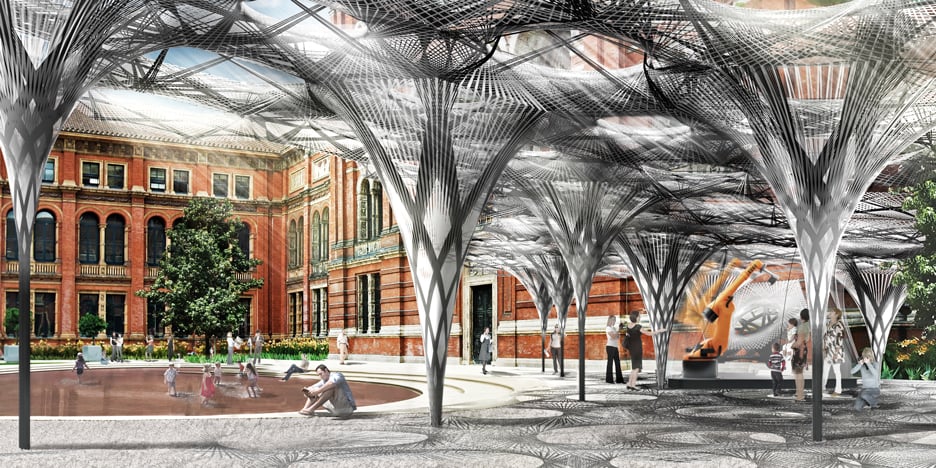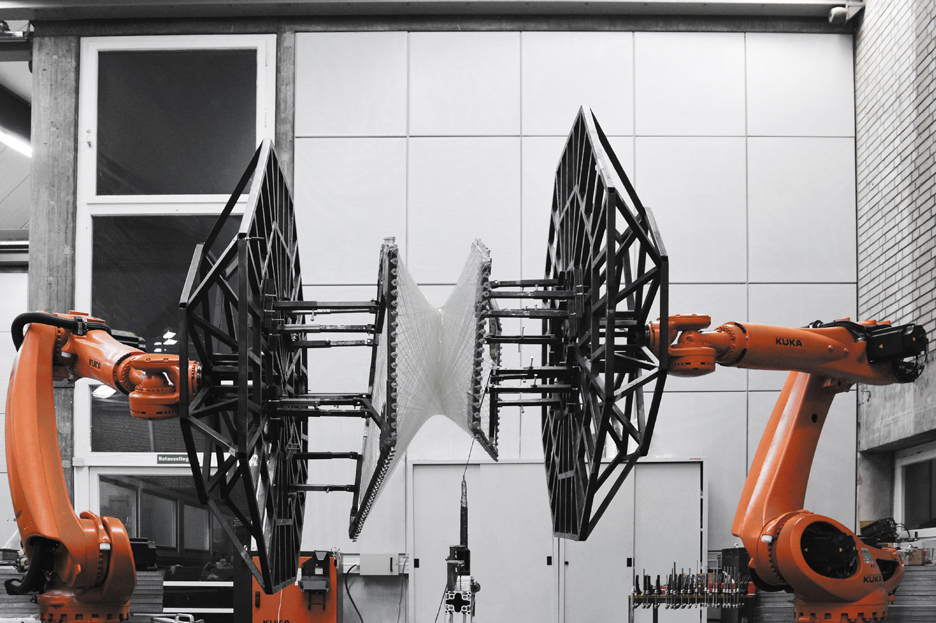Robot-built pavilion proposed by Achim Menges for V&A museum courtyard
Stuttgart architect Achim Menges has developed designs for a robot-fabricated pavilion based on the wings of flying beetles, which will be erected in the V&A museum courtyard in London.
Menges is working with architect Moritz Dörstelmann, and engineers Jan Knippers and Thomas Auer on the Elytra Filament Pavilion, which is being constructed as part of the V&A's Engineering Season.
The undulating and web-like structure of the canopy will be based on the fibrous structures found in the hardened forewings of flying beetles, known as elytra. A robot will construct the design from carbon fibre.
"With Elytra: Filament Pavilion, we aim to offer a glimpse of the transformative power of the fourth industrial revolution currently underway, and the way it again challenges established modes of design, engineering and making," said Menges, who founded the Institute for Computational Design at Stuttgart University.
"Built entirely from robotically produced fibrous systems, the pavilion will intensify the visitor's experience of the V&A's garden by providing a differentiated and evolving space. Its intricate, filament canopy is at the same time architectural envelope, load-bearing structure and environmental filter, which will extend and transform over time."

The installation seeks to explore the impact of emerging robotic technologies in architecture and engineering. It follows on from Menge's previous pavilion projects, including another one inspired by beetle wings and one based on a lobster's exoskeleton.
Construction of the pavilion will continue over the duration of the season, between May and November, with new cells fabricated in response to data collected by sensors in the canopy fibres.
The robot that will be used is produced by Kuka, a German manufacturer that creates robots for various tasks including spot welding and table tennis.
The V&A Engineering Season also includes the first major retrospective of Ove Arup, the 20th-century engineer behind the Arup group.
The exhibition will look back at Arup's early projects including Berthold Lubetkin's Penguin Pool at London Zoo, as well as Jørn Utzon's Sydney Opera House and the Centre Pompidou in Paris by Richard Rogers and Renzo Piano.

The firm's more recent feats of engineering for Crossrail and open-source housing design will also be explored.
"We may not know it, but engineers organise the world we live in," said the V&A's director Martin Roth. "Our lives are reliant on visible and invisible systems conceived, built, run or facilitated by the many disciplines of contemporary engineering."
"The V&A Engineering Season is a clear statement in our renewed interest in industrial design and the engineer," added Roth. "It builds on our industrial design heritage and reflects the crucial role of engineering in the development of the V&A."
Coop Himmelb(l)au founder Wolf D Prix previously spoke to Dezeen about the “amazing" opportunities offered to architecture in terms of complexity and speed by robotic fabrication with 3D printing.
"I think the combination of robotic construction and 3D printing is the future of the building industry," the Austrian architect told Dezeen.
The V&A Engineering Season will also highlight projects by British engineering firms including AKT II, Atelier One, Buro Happold, Expedition Engineering and Jane Wernick Associates, and a symposium led by Achim Menges about biomimicry, design and engineering.
British architect Amanda Levete is currently working on a new entrance and subterranean gallery for the museum, which is scheduled to complete in early 2017.
Images are courtesy ICD/ITKE University of Stuttgart.